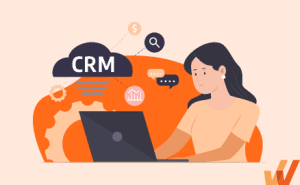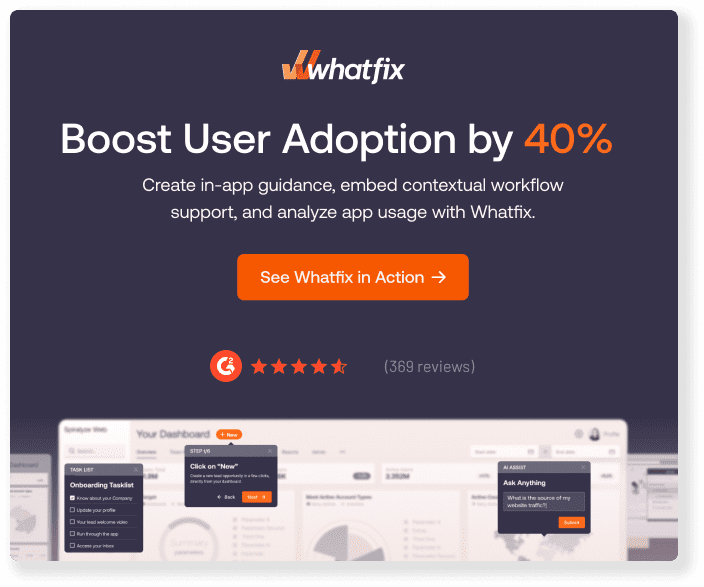CRMs are the backbone of sales organizations, providing the business processes that enable frictionless selling, a centralized communication hub to track deals and customer comms, and the data to unlock sales growth.
They offer you one source of truth for managing sales ops, increase sales (29%), productivity (34%), and forecast accuracy (42%), and return a $8.71 ROI for every $1 you spend on it—when you get it right.
But CRMs can quickly become more of a burden than a benefit. These systems often create new problems while trying to solve existing ones. Without proper planning and execution, your CRM investment risks becoming expensive shelfware that your team actively avoids using.
This article tackles the most common CRM challenges head-on, offering practical solutions to transform your CRM from a potential roadblock into a powerful revenue driver.
What are the most common CRM challenges?
- CRM onboarding and training for new sellers
- Promoting end-user adoption
- Maintaining high CRM data quality
- Managing cost-effectiveness
- Using data to identify seller friction and optimize CRM processes
- Integrating data sources and sales tools with your CRM
- Creating a strategic CRM plan
- Facilitating effective seller communication
- Offering customization and flexibility
- Delivering accurate reporting and analytics
- Upholding data security and compliance
- Ensuring vendor reliability and support
- Securing leadership buy-in
- Selecting the appropriate CRM system
14 CRM Challenges in 2025 & How To Overcome Them
Here are the top 14 challenges you’ll likely encounter while choosing, deploying, and using a CRM day-to-day and strategies to help you mitigate them.
1. CRM onboarding and training for new sellers
Poor CRM onboarding slows down sales and creates messy data that affects the whole team. Traditional training methods like long documentation or one-time CRM user training sessions don’t work well. Sales reps forget most of what they learn and need different help depending on their role and experience.
Whatfix solves this by providing guidance right inside your CRM. Sales reps see interactive walkthroughs for their specific tasks, get instant help when stuck, and learn the system while doing their actual work. The platform tracks what parts of the CRM cause the most confusion so you can fix problem areas quickly.
Plus, with Whatfix Mirror, organizations can create CRM sandbox environments to provide hands-on CRM training experiences for their team. All in an interactive, risk-free application environment.
2. Promoting end-user adoption
While 91% of companies with 10+ employees use a CRM, a survey of 1,000 sales professionals by SugarCRM shows that 52% of sales leaders report that their CRM costs them opportunities; 50% of companies surveyed couldn’t access customer data across marketing, sales, and service, while 48% of decision-makers said their CRM didn’t meet their needs and gave them an insufficient, outdated view of their customers.
The problems show up in daily work. Sellers skip logging deals, leave contact information blank, and work around the CRM instead of in it. You may wonder why you might be facing resistance from your salespeople about picking up yet another CRM.
If you’re serious about accelerating your sales, you must enable your users with a CRM adoption strategy. You can enable your sellers to use your CRM efficiently by:
- Creating a library of self-help content that sellers can use to solve issues or find the right sales documentation when needed
- Host regular 1:1 coaching sessions, webinars, and training programs to help your employees understand your CRM better
- Use in-app guidance tools like Whatfix to guide users through your CRM’s interface.
With a DAP like Whatfix, sales organizations can maximize ROI from their CRM and its custom workflows. Whatfix enables sellers with in-app guided flows, task lists, tooltips, and more— all guiding them through contextual tasks related to their day-to-day.
Whatfix also supports sellers when needed with an embedded Self Help wiki that automatically crawls all your sales documentation, sales playbooks, and CRM process support. Sellers can search this Self Help wiki to find answers at the moment of need, right inside the CRM.
CIOs and leaders can use Whatfix’s analytics capabilities to understand in-app guidance usage, map common user flows, identify CRM workflow friction points, track custom events, and more. This empowers sales leaders with the data to create the most effective and efficient CRM workflows and drive CRM adoption.
3. Maintaining high CRM data quality
According to Validity’s 2022 State of CRM Data Management Report, the average organization’s CRM has less than an 80% data accuracy rate, while 44% of respondents said their company lost 10% of their annual revenue due to poor quality data.
Without reliable data, your SDRs and AEs will spend precious time chasing decision-makers who may have left their organization, reaching out to inaccurate addresses, and repeatedly missing their revenue forecasts.
To maintain higher CRM data quality, you’ll need to implement better governance policies to restrict CRM write permissions and use reliable CRM data migration tools to ensure integrity during and after exporting your customer database to your new CRM.
Whatfix can help by guiding new users on correct field entries or prompting them to fill in your mandatory fields. This way, your organization can minimize the risks that come with having messy data.
4. Managing cost-effectiveness
Pricing for basic CRM packages (e.g., Less Annoying CRM, Apptivo, Trello, and Folk) tends to range between $10 and $20/user/month, while enterprise CRMs (SAP, NetSuite, Salesforce, etc.) can go as high as $300 for the same duration.
At that price point, a medium-sized organization with a team of just 300 AEs, SDRs, and sales-adjacent roles would spend $1.08M annually on an enterprise CRM deployment.
But looking at license costs alone misses the bigger picture. A true Total Cost of Ownership (TCO) calculation should include:
- Implementation and customization costs
- Integration expenses
- Training and change management
- Ongoing maintenance and support
- Lost productivity during adoption
- Data migration and cleanup
CRMs are costly investments, but for good reason. While a basic CRM might permit you to create contacts, manage custom fields, access your CRM on a mobile device, and customize your interface to suit your branding, enterprise CRMs are an entire ecosystem that can:
- Integrate with hundreds of third-party platforms
- Build custom apps on top of their APIs
- Create if-then CRM workflows that trigger tasks in other tools when a condition is met
- Automatically update a customer’s status based on predefined conditions
- Generate customizable reports and track performance by individuals and teams
- Hand off conversations to different team members
- Get a 360-degree overview of different communication channels in one place (e.g., WhatsApp, email, Facebook, Instagram, etc.)
While it’s okay to opt for a CRM that offers the most value for a reasonable price, you’ll need to have a decent budget (say, $20 to $90/user/month) that reflects your company size and how complex the solution you expect to tame your sales process should be.
5. Using data to identify seller friction and optimize CRM processes
Many companies can’t see where their sales teams struggle with CRM workflows. Whatfix’s Product Analytics solves this by tracking exactly how sellers use your system. You can see which tasks take too long, where people give up, and which features they ignore.
Process funnels show where work gets stuck. By comparing how different teams work, you can identify bottlenecks. This insight helps you make smart changes to your CRM. You can simplify screens where people get stuck, add guides for confusing steps, and remove unnecessary fields. Instead of guessing what works, you can make decisions based on real data.
6. Integrating data sources and sales tools with your CRM
When tools don’t connect properly, your team wastes time copying data between systems and valuable information gets lost. You need a clear plan for connecting everything. Start by listing your essential integrations. Common ones include email (Gmail, Outlook), calendars, calling tools (like RingCentral), document storage (Google Drive, SharePoint), and communication platforms (Slack, Teams).
Your CRM should automatically sync data between these tools, but watch out for data sync issues. The goal is to give your sales team one place to work without jumping between different tools all day.
7. Creating a strategic CRM plan
If you limit your CRM usage to just recording customer details, creating opportunities, and tracking them from interest to purchase, you’re leaving money on the table—in fact, it’d be better if you used a spreadsheet or a database instead.
CRMs are infinitely more powerful— but to maximize their functionality, you need to first create an action plan to utilize your CRM’s functionality and tailor the platform to your sales process, and vice versa.
- Define your goals for adopting a CRM: Are we trying to grow revenue, increase our NPS, reduce churn, increase customer satisfaction, or all of the above? Note it down.
- Create an ideal customer persona, including profile details such as their position, age, team size, salary, budget, pain points, etc.
- Describe your customer journey: How do customers navigate from not knowing about your product, to awareness, discovery, interest, purchase, and eventually retention?
- How do you intend to guide customers through your sales process and retain them with after-sales support?
- Which products in your software stack do you intend to integrate with your CRM?
8. Facilitating effective seller communication
When you have dozens—or hundreds—of employees creating records, contacts, and opportunities, booking meetings, and closing deals, it’s a given that they’ll work together inside the same platform, right?
Not always.
However, it’s important to overcome sales technology challenges and focus on making collaboration easier for teams. According to research from Deloitte, organizations capable of deploying cross-functional teams may realize increased gains in adaptability, innovation, and responsiveness, leading to lower operating costs and higher profitability.
While a CRM can be a powerful tool for collaboration in growing companies and enterprises, it often becomes yet another silo for SDRs and AEs to sequester their deals and opportunities away from the rest of their team. For you to maximize the collaboration features your CRM is equipped with, you need to intentionally:
- Assign different teams to collaborate throughout the sales process
- Re-assign action items to team members depending on their previous performance
- Hold regular 360-degree reviews for your entire sales force
9. Offering customization and flexibility
Just how much can you customize your CRM to your unique use cases? While your CRM platform may solve most of your organization’s sales-related pain points as is (such as ticketing, creating and managing contacts, conversations, and opportunities), you’ll be extremely limited if you rely only on the functionalities your CRM offers out of the box.
As a result, you might have to switch CRMs often as your company scales up, trying to find a platform that grows with you.
Before you opt for a CRM, you need to ensure that it:
- Can provide your organization with tools to build custom customer and sales-related workflows required to achieve your business outcomes.
- Supports an extensive library of CRM integrations with your existing software stack, whether natively or via connectors like Zapier.
- Can build custom applications on top of your APIs and expand their functionality to suit your company’s size as you scale up.
- Has a native data export suite or is compatible with mainstream CRM data migration tools like Pentaho and Talend Open Studio.
Heavily customized CRM instances and workflows present additional challenges for CIOs and sales leaders, as the CRM vendor’s out-of-the-box onboarding, guidance, and training won’t be contextual to how your sellers use the platform.
With an in-app guidance tool like Whatfix, organizations can build contextual in-app flows, tooltips, pop-ups, field validations, and other forms of user assistance and support to enable sellers to create customized tasks and workflows. Contextual guidance can reduce confusion and training time so your team gets up to speed faster.

10. Delivering accurate reporting and analytics
More than just serving as your sales team’s second brain, a CRM should break down all that data into digestible reports and summaries tracking your key metrics, such as:
- Customer lifetime value (CLV): The total revenue you expect from a customer throughout your relationship. For example, if a customer spends $100 monthly for 3 years, their CLV is $3,600.
- Customer churn rate: The percentage of customers who stop using your product in a certain period. If you start January with 200 customers and lose 10 when the month ends, your monthly churn rate is 5%.
- Net promoter score: Ratings from customers that show how likely they are to recommend your product from 0-10.
- Customer acquisition cost: The total cost to acquire one new customer, including marketing and sales spend. If you spend $10,000 to acquire 100 customers, your CAC is $100.
- Average sales cycle length: The time it takes to convert a lead into a customer. If it typically takes 45 days from first contact to closed deal, that’s your average cycle length.
- YoY growth: The percentage increase in metrics compared to the same period last year. For example, if revenue was $1 million last year and is $1.2 million this year, YoY growth is 20%.
- Annual contract value: The yearly revenue from a single customer contract. A customer paying $1,000/month has an ACV of $12,000.
- Win rate: The percentage of deals you close. Closing 30 deals out of 100 makes your win rate 30%.
- Average revenue per user: The average monthly or annual revenue generated by each customer. If 100 customers generate $50,000 monthly, your monthly ARPU is $500.
—among other essential customer experience metrics and KPIs.
Sadly, your CRM may not be designed to let you customize your reporting UI to your taste or might not even render the aforementioned metrics. Instead, you can use third-party analytics tools to export that data, model your organization’s financial health, and forecast future sales figures in advance.
11. Upholding data security and compliance
Your CRM will serve as the hub for most of your customer relationship communications and will store sensitive information about your company’s finances and your customers, including their social media profiles, email addresses, physical addresses (i.e., office location), phone numbers, personality traits, and purchasing habits.
In the hands of a bad actor, any of these data points would make for disastrous usage.
Before you choose a CRM vendor, it’s essential to confirm that they offer sufficient server-side security, using tools and policies such as multi-factor authentication (MFA), data encryption, real-time event monitoring, and threat detection to mitigate attacks.
Depending on your specific use case, you can also filter for CRMs that are compliant with both mainstream and niche security protocols such as HIPAA, ISO 27001, IASME, NIST Cybersecurity Framework, etc.
12. Ensuring vendor reliability and support
The average early-stage technology startup lasts just seven years before shutting down, and while your CRM vendor will most likely be a cash flow-positive business with a healthy business model, it never hurts to confirm.
Before moving your organization’s sales and customer ops to a new CRM, you need to investigate the developer to learn about their financials. Even more importantly, how much support do they guarantee if you run into technical issues using their product?
The best time to lock down favorable policies is at the contract stage, when you can examine your service-level agreement (SLA) to understand the quality of support offered, technical and material, and any on-demand resources they provide for troubleshooting issues independently.
13. Securing leadership buy-in
The decision to invest in a CRM often comes straight from leadership, and securing buy-in is usually not a problem. But, if you propose the idea as a mid-to-senior executive, you’ll need to prove ROI and create an adoption plan to allay the C-Suite’s fears of burning cash on shelfware no one will use.
- Proving ROI: Nucleus Research estimates that every $1 spent on a CRM returns $8.71 in ROI. But you can’t just chuck that figure in a PowerPoint and consider it done. You need to highlight inefficiencies in your existing sales process, explain how a CRM will eliminate them, and build your case on how a smoother sales process will lead to high revenues and profits.
- Create an adoption game plan: Do we need a phased deployment to test expected vs. actual performance? What about a free trial before commitment? How much do we need to invest in training, 1:1 coaching, and technical support after the initial deployment? How much do you estimate this project will go over budget? You’re more likely to gain buy-in for your CRM deployment if you show you have a good grip on your numbers and that you can paint an accurate picture of how it will develop.
14. Selecting the appropriate CRM system
According to G2, there are at least 868 CRM platforms on the market. That list easily doubles when you factor in lesser-known SMB solutions and database tools like Excel, Notion, Airtable, and ClickUp that can do a decent job. Use this process to make an informed decision without getting overwhelmed.
Step 1: Define your requirements
- List essential features your team needs
- Determine your must-have integrations
- Set your user count and storage requirements
- Establish your budget for licenses and maintenance
- Identify your non-negotiable security requirements
Step 2: Get input from stakeholders
- Survey your sales team about their workflow needs
- Consult IT about technical requirements and security
- Get finance team input on budget and ROI expectations
- Document specific pain points each team wants to solve
Step 3: Create your shortlist
- Research 3-5 platforms that match your requirements
- Focus on CRMs used successfully in your industry or by peers
- Consider bringing in a CRM consultant
Step 4: Test and evaluate
- Run pilot programs with your top 2-3 choices
- Test workflows with actual team members
- Evaluate customer support quality
- Compare pricing against your budget
- Check on vendor stability and market presence
Remember, the best CRM is not necessarily the one with the most features but the one that aligns best with your team’s workflow and objectives. Make informed decisions, keep the end-user at the heart of the selection process, and you’ll find a CRM that solves sales technology challenges instead of contributing to them.
3 Important Steps to Avoid Pitfalls in CRM Adoption
Ready to implement a CRM in your organization? These are the three most important actions that will help your CRM succeed:
1. Fix your data quality issues
Most companies struggle with messy CRM data. Wrong contact information, duplicate records, and outdated details. Here’s what works:
- Set up validation rules that prevent users from entering incorrect data formats
- Run monthly data cleanup projects to fix duplicates and errors
- Create clear guidelines for how teams should enter customer information
- Use data enrichment tools to automatically update company and contact details
2. Create a clear plan before launch
Many companies buy a CRM without planning how they’ll actually use it. It’s possible to avoid this when you:
- Write down which problems you want the CRM to solve
- Map out your entire sales process step by step
- List all the tools your team currently uses and plan how they’ll connect to the CRM
- Set specific goals (like “reduce time spent on data entry by 50%”)
- Start with a small team before rolling out company-wide
3. Focus on user adoption and experience
A CRM only works if your team uses it consistently. Do these things to make that happen:
- Show teams exactly how the CRM will make their jobs easier
- Create short video tutorials for common tasks
- Set up regular training sessions where teams can ask questions
- Track which features people struggle with and create resources to help
- Have experienced users mentor new team members
CRM Adoption Clicks Better With Whatfix
A CRM is only as powerful as your usage of it. To generate a positive ROI on your investment, you need to encourage adoption, remove blockers that might confuse your salespeople, and demonstrate that your CRM is a more efficient tool for managing the sales process than your team’s current ad hoc solutions. That’s where Whatfix comes into play.
Whatfix is a digital adoption platform (DAP) that integrates seamlessly with enterprise CRMs, including Salesforce, SAP, and Microsoft Dynamics. Our solution helps enterprises adopt new software using tactics such as:
- Step-by-step product tours
- Guided walkthroughs customized by role, location, and any variable you choose
- Self-help widgets embedded on every page of your CRM’s UI so users can search through product docs, pre-recorded demos, and help articles
- Predictive content localization that translates your CRM’s UI into your employees’ preferred language, with support for 70+ languages
- Product analytics that tracks who uses which part of your CRM so you can better project how to drive adoption forward
Request a Whatfix demo and see how quickly your sales ops can transform with real-time guidance and actionable insights.












